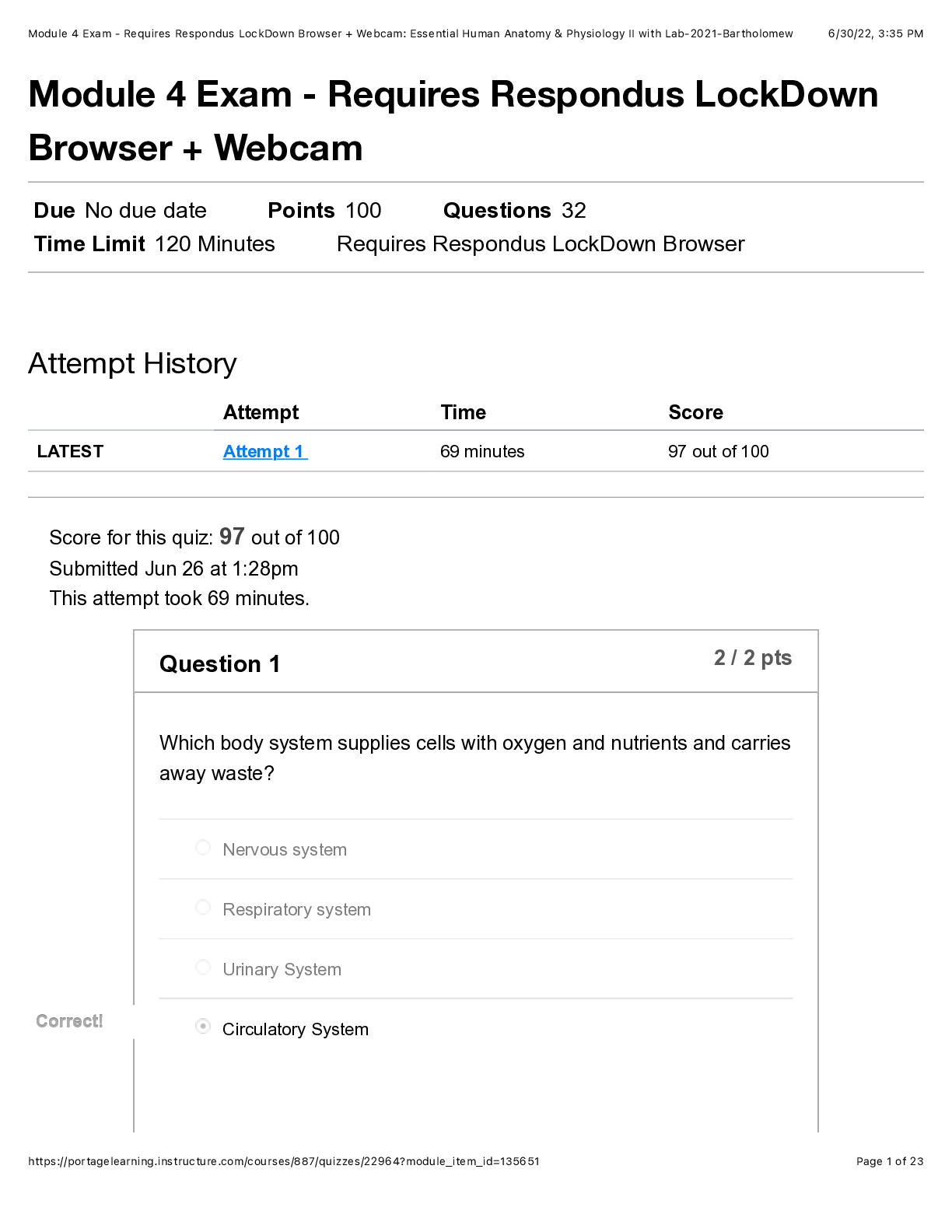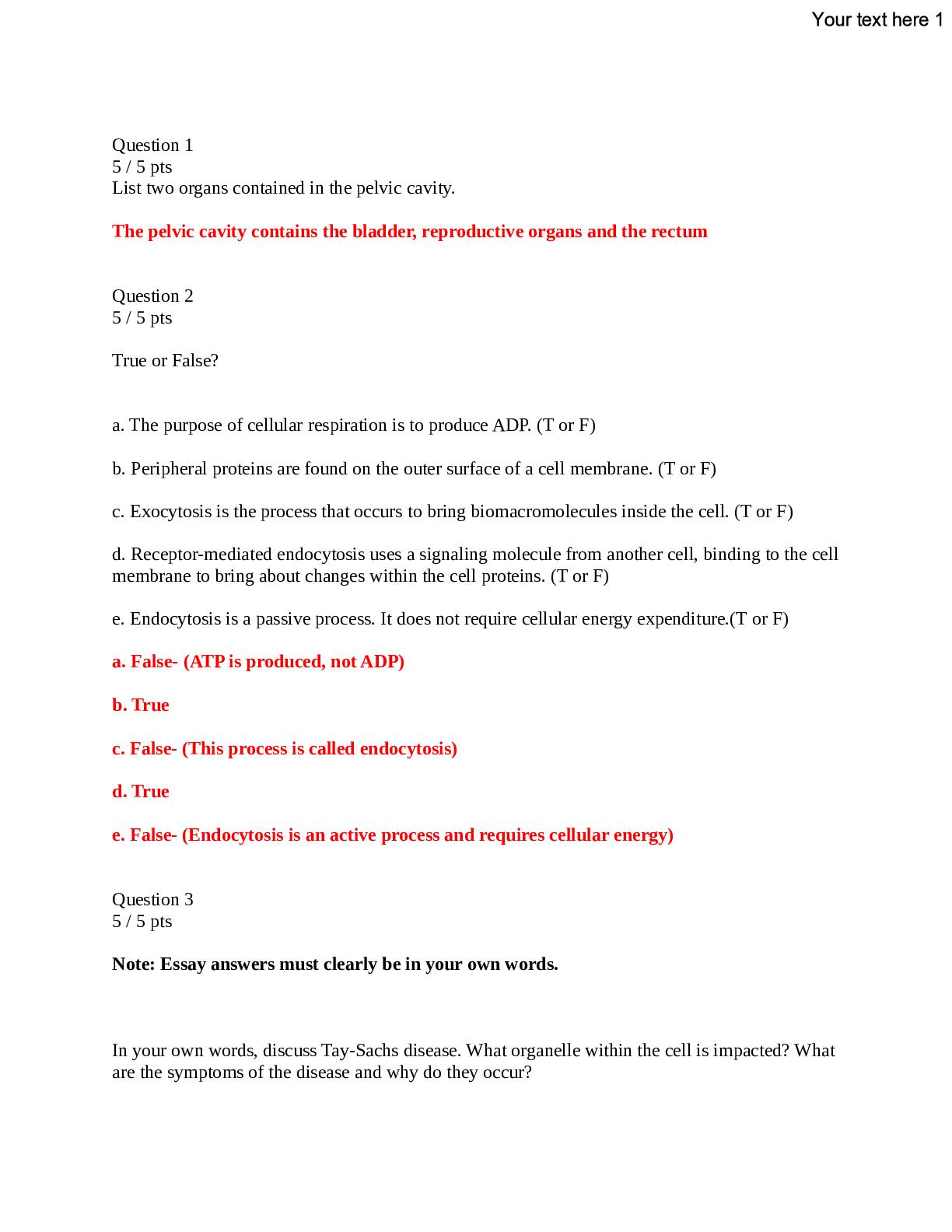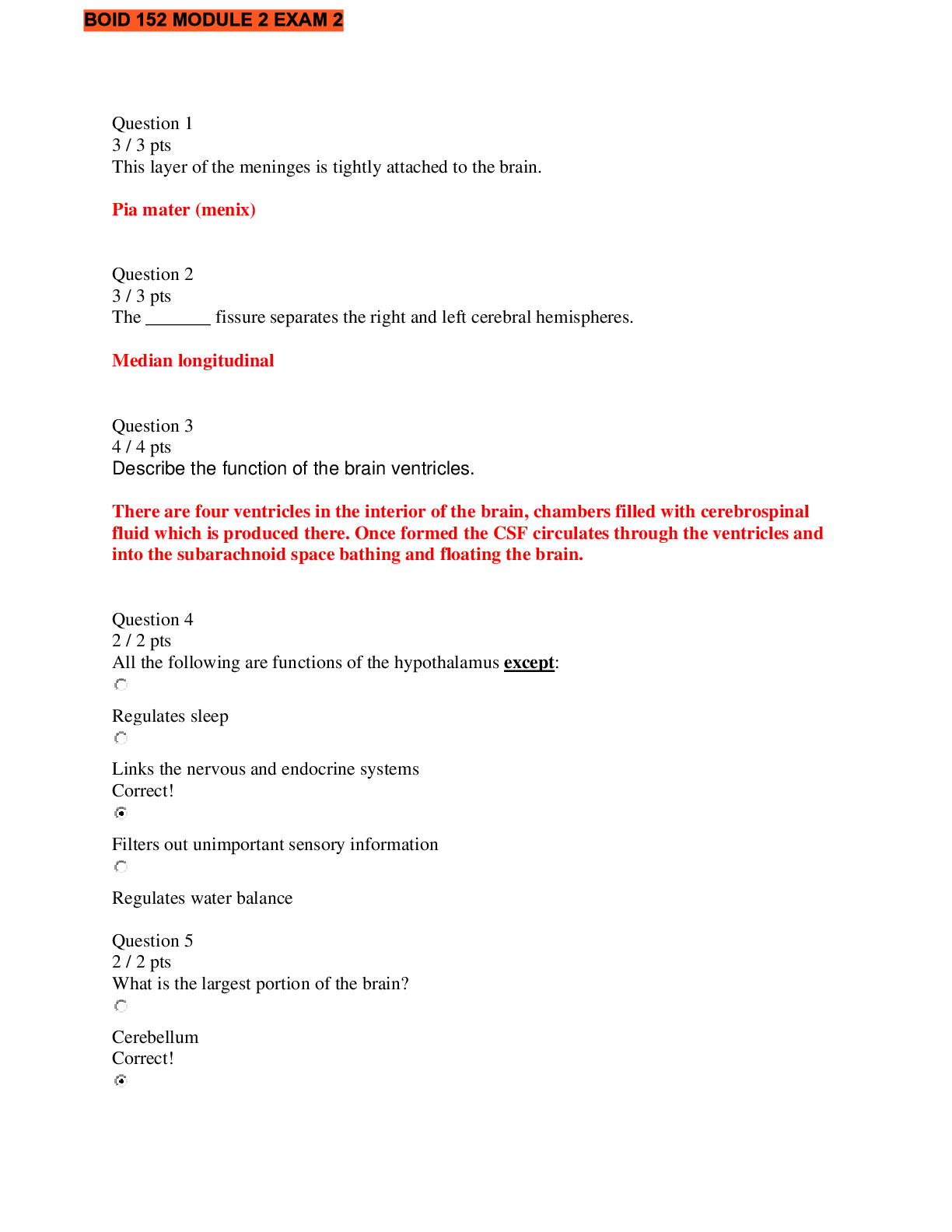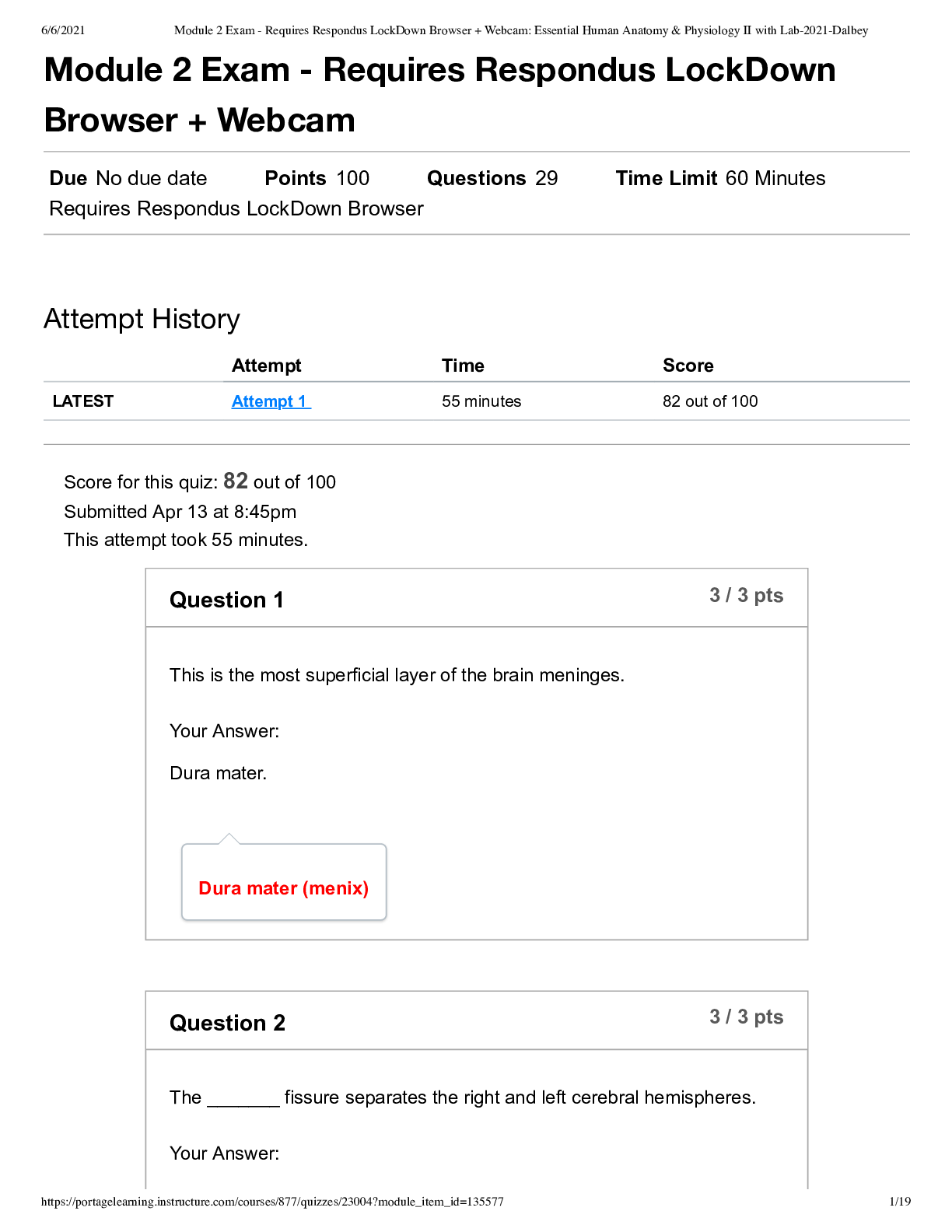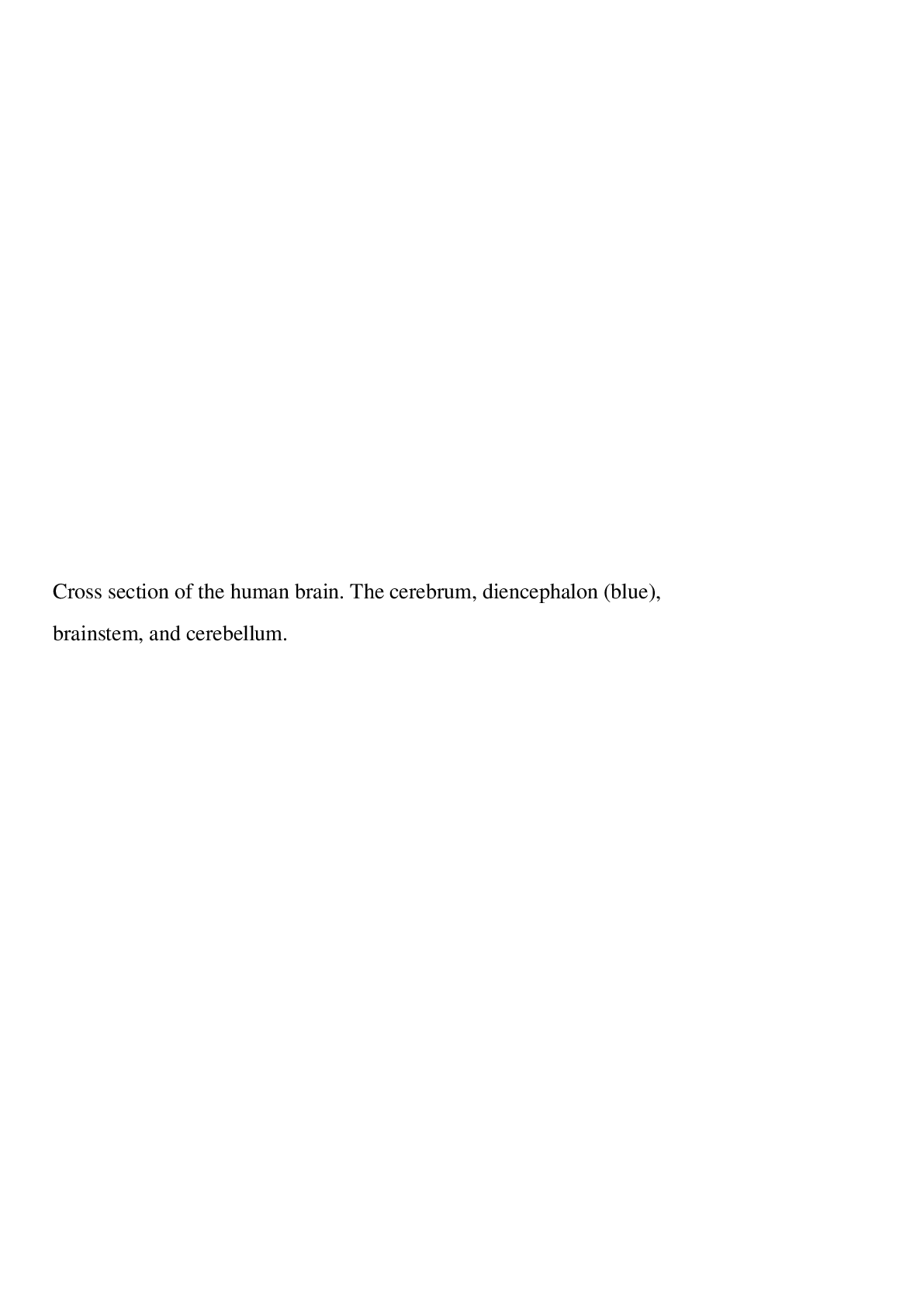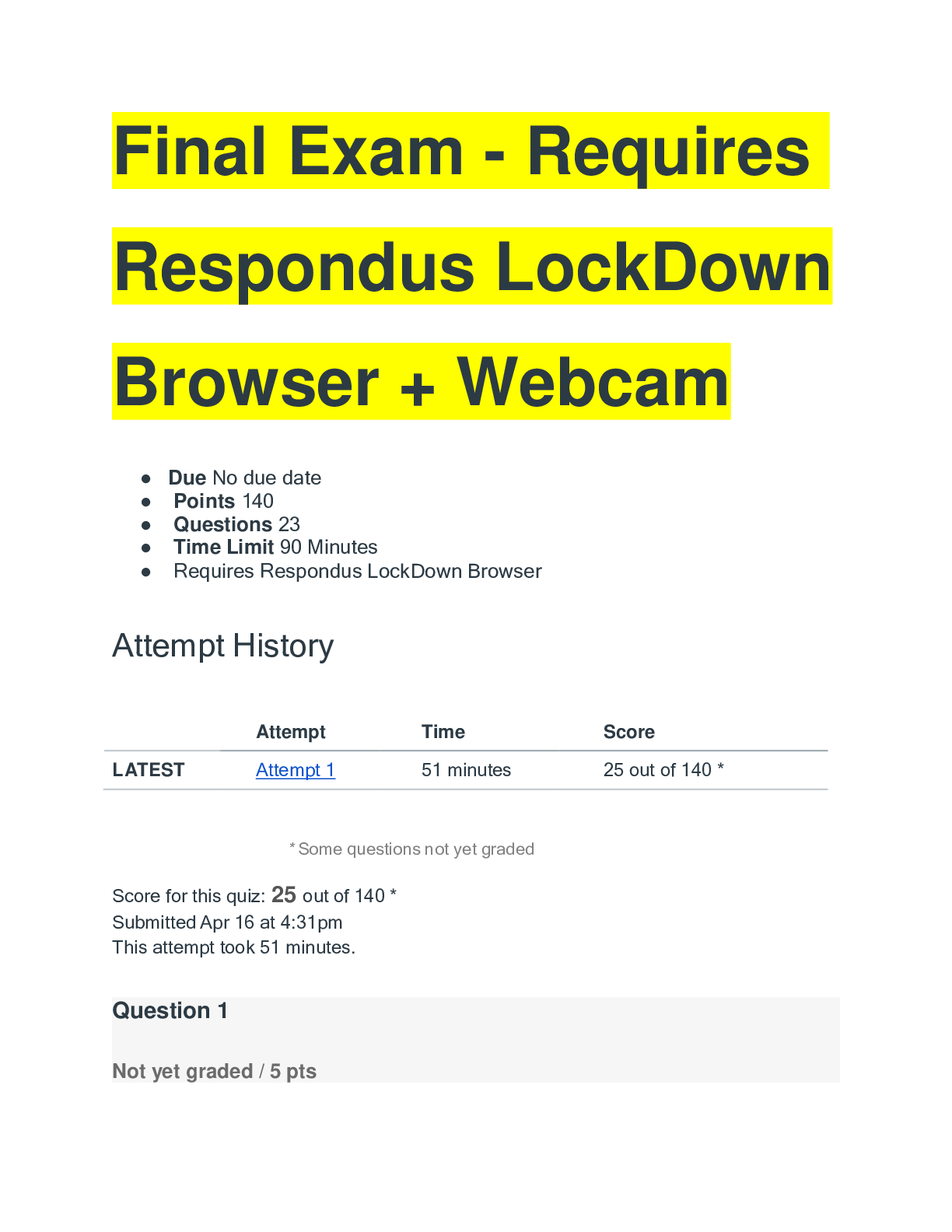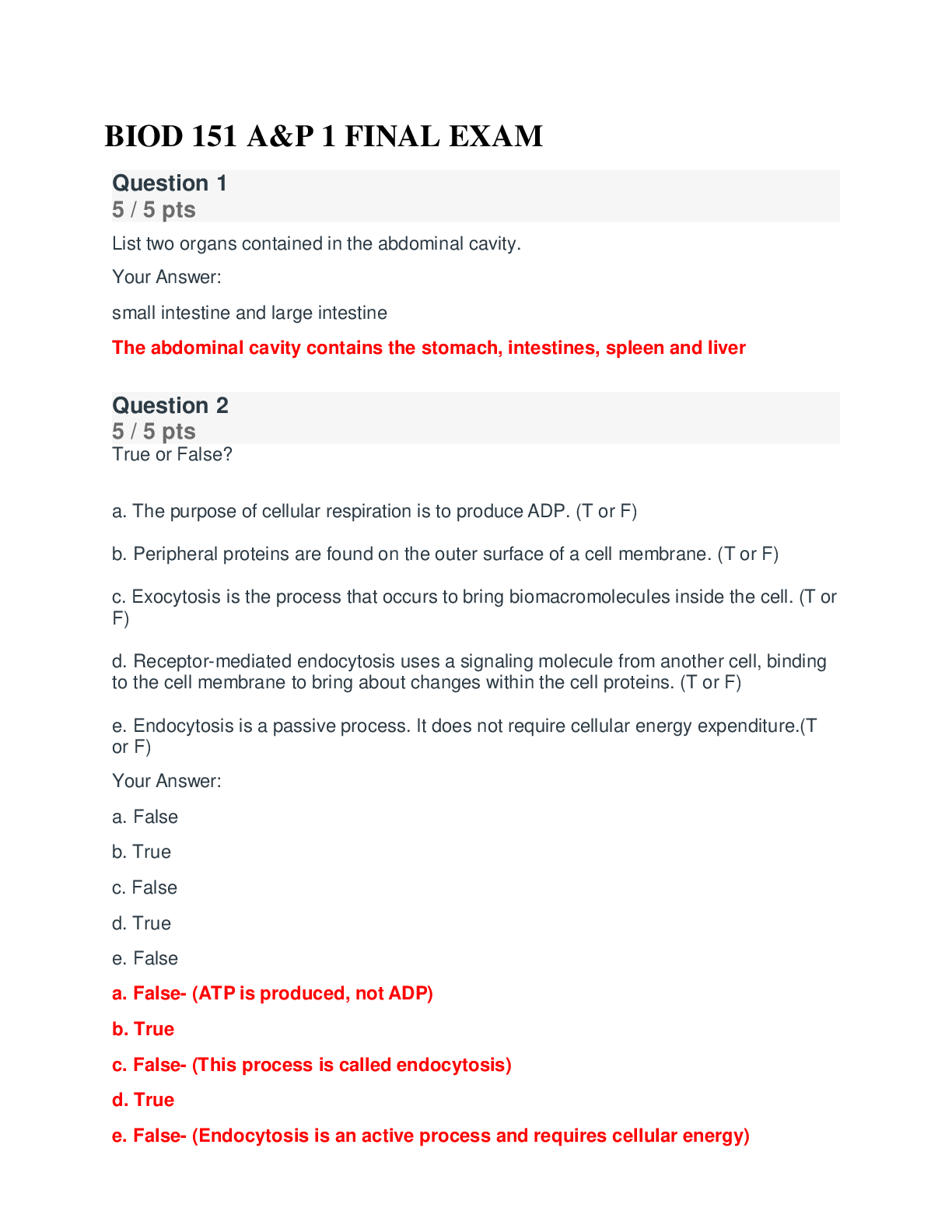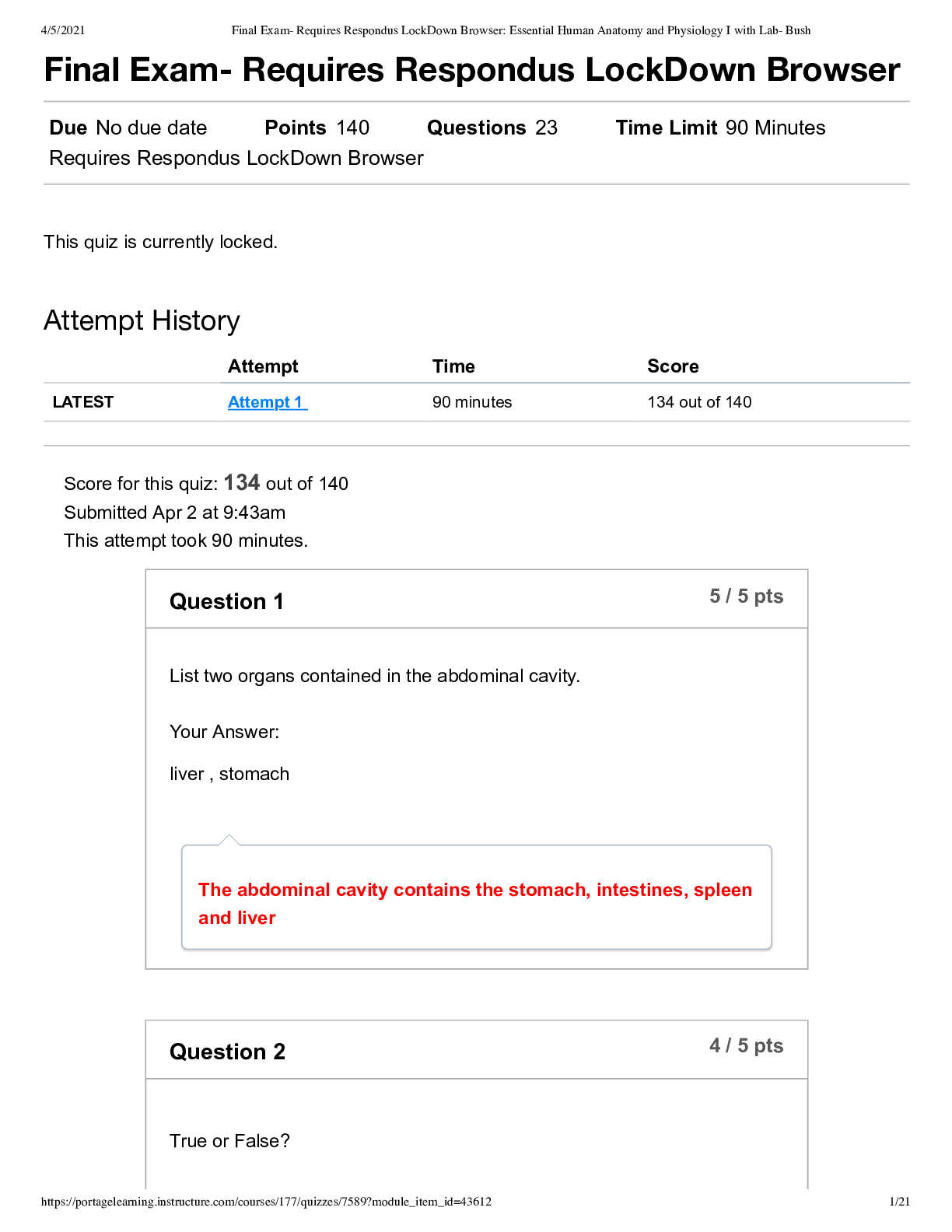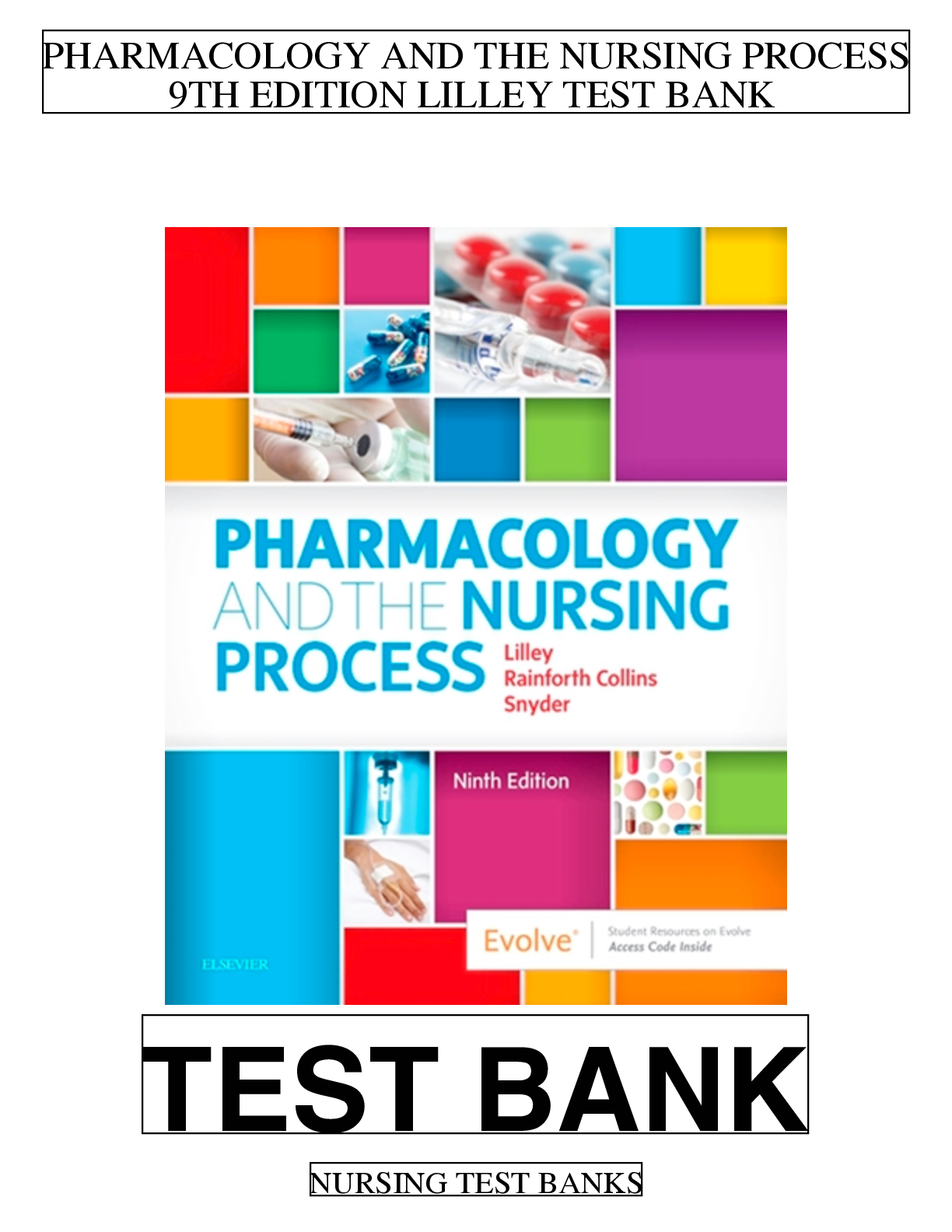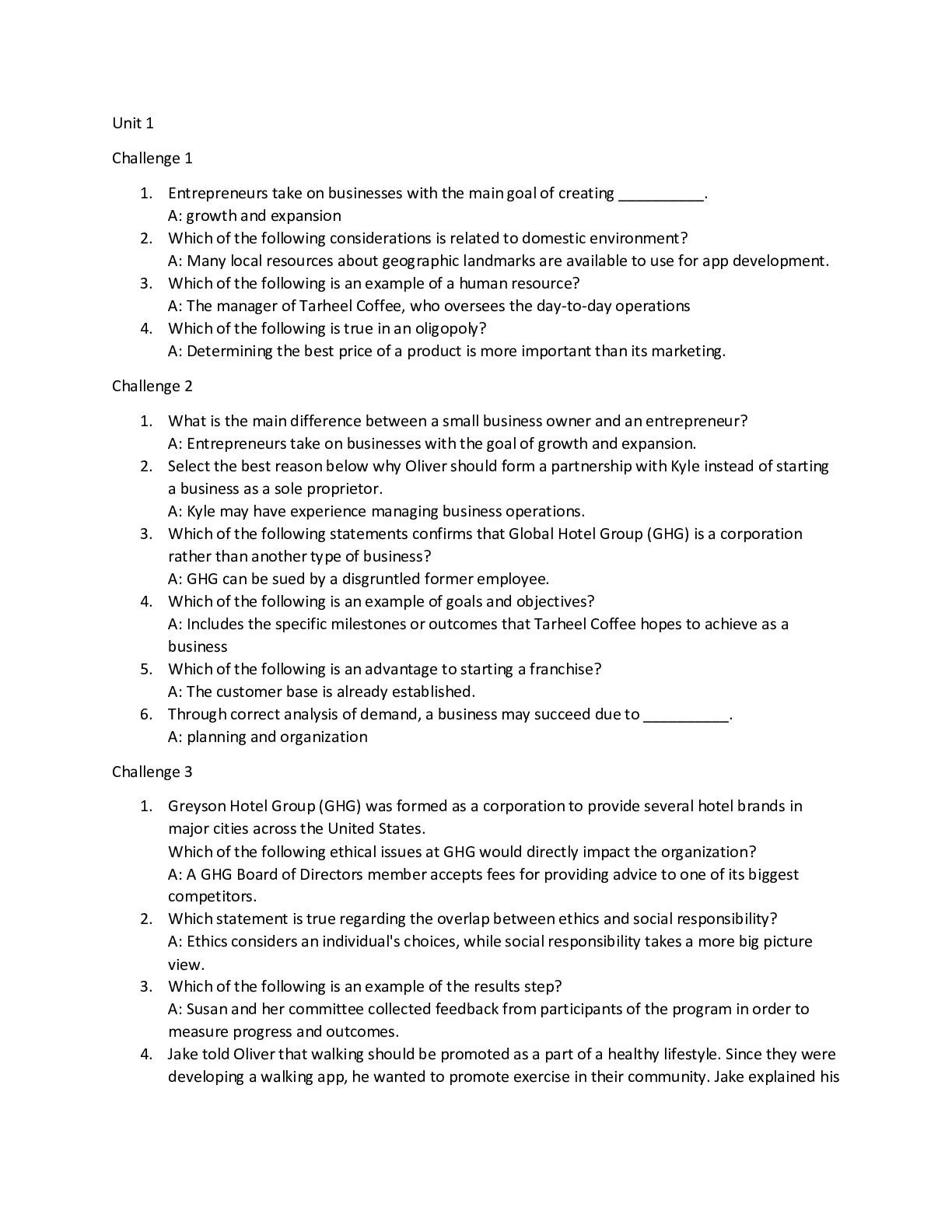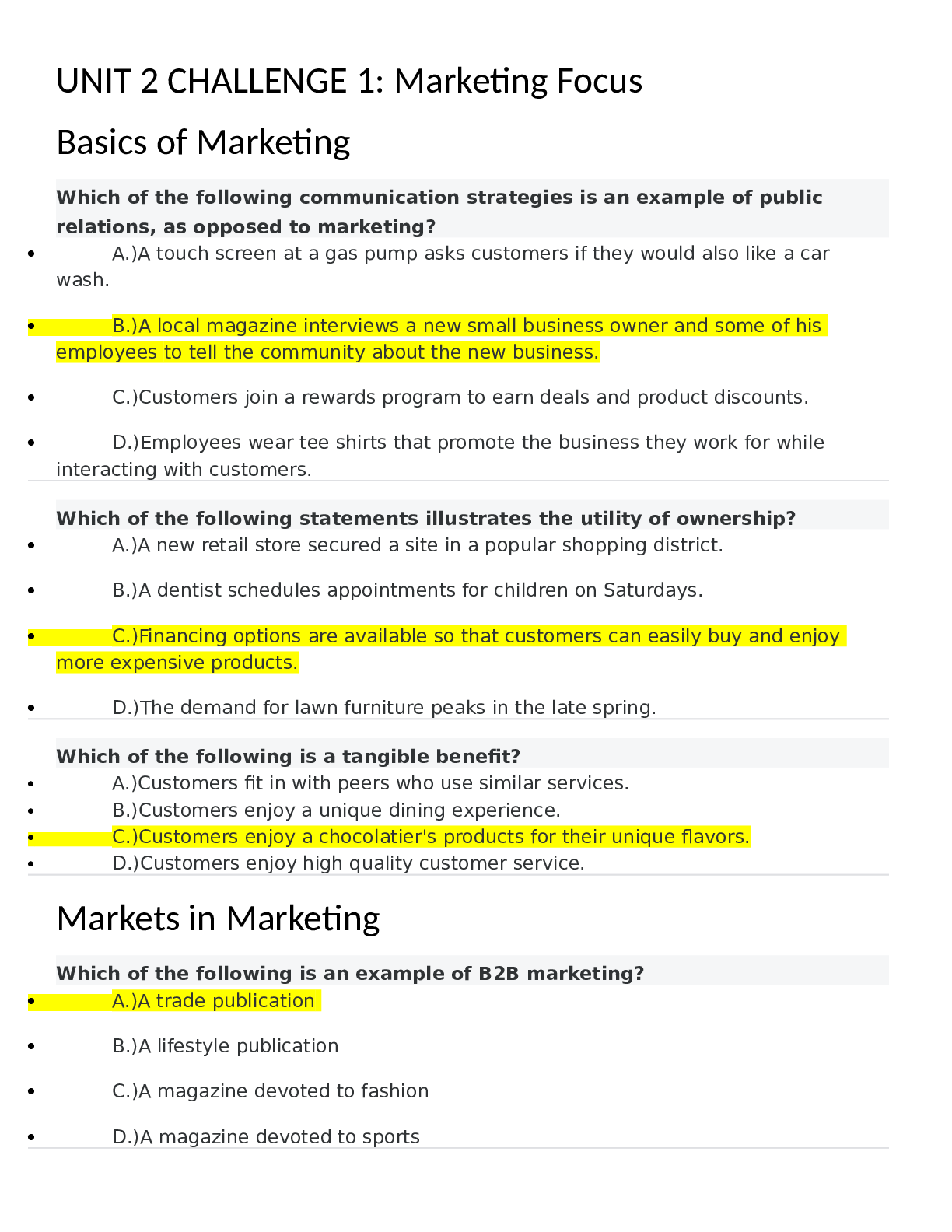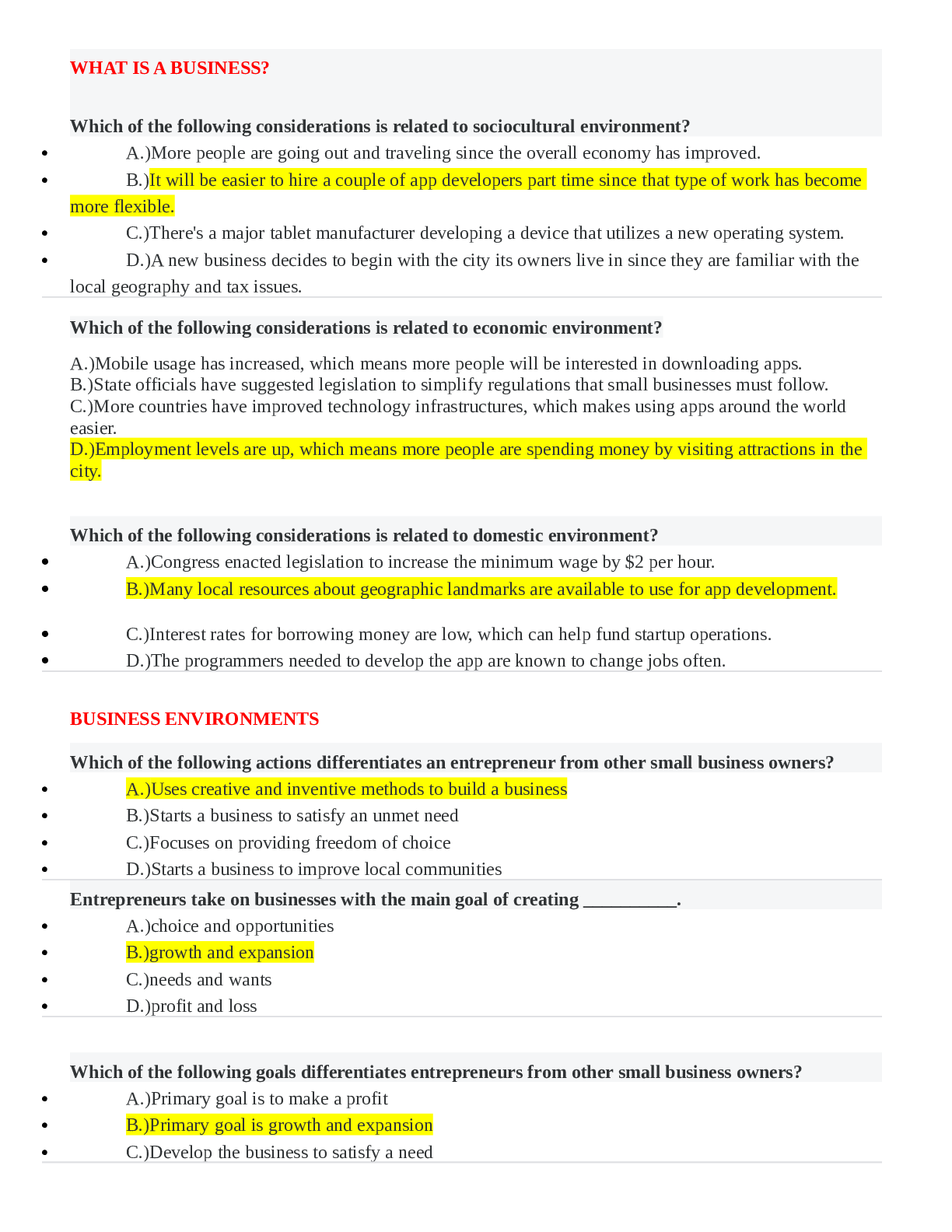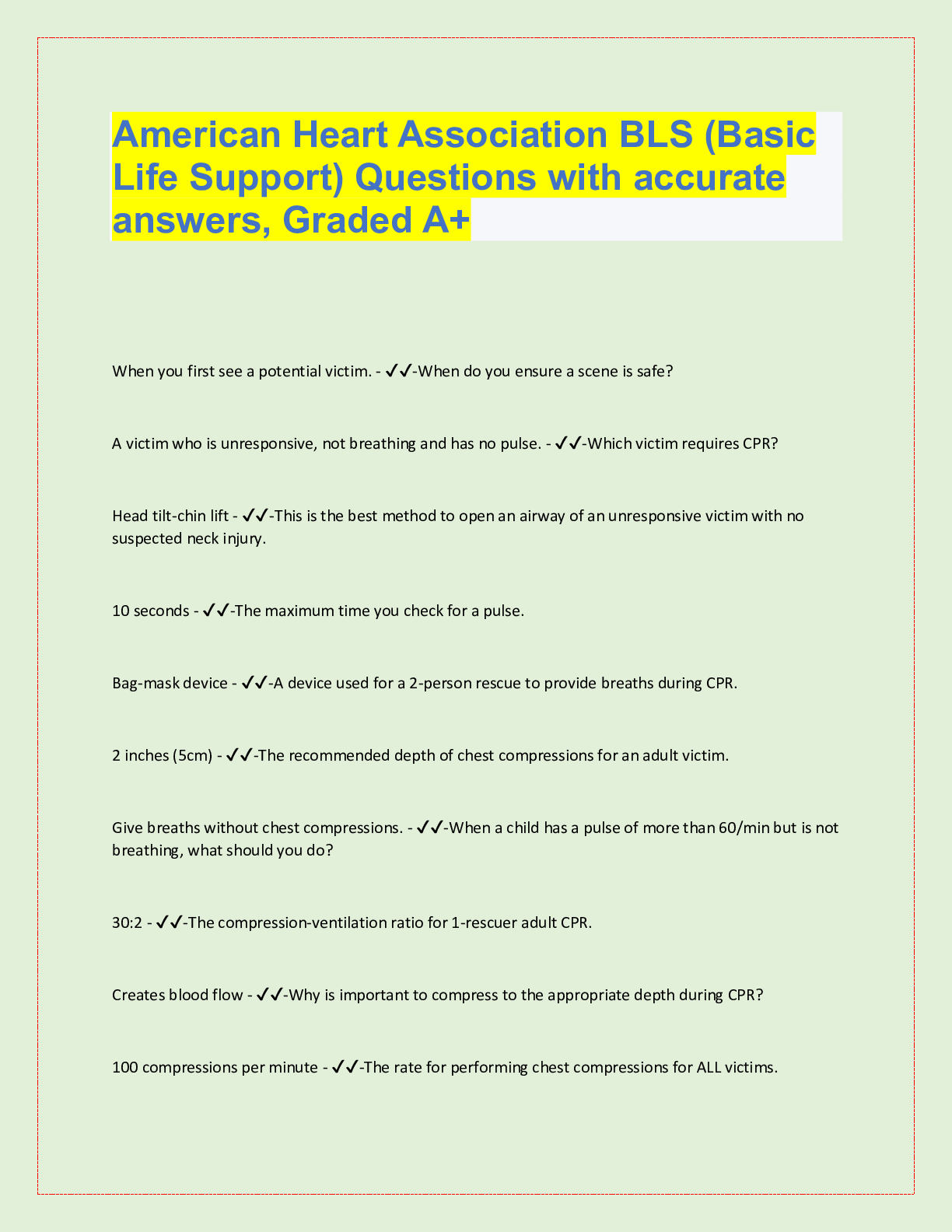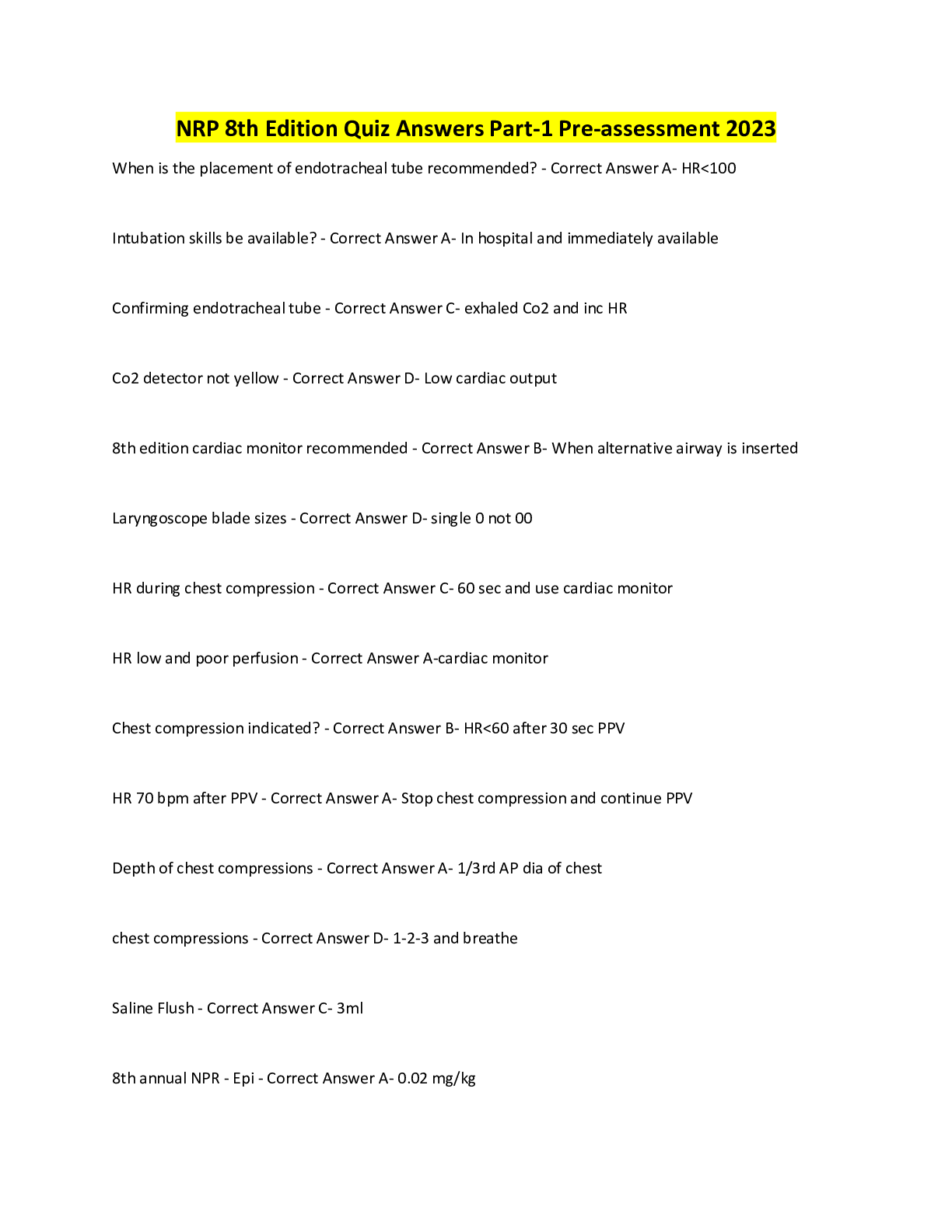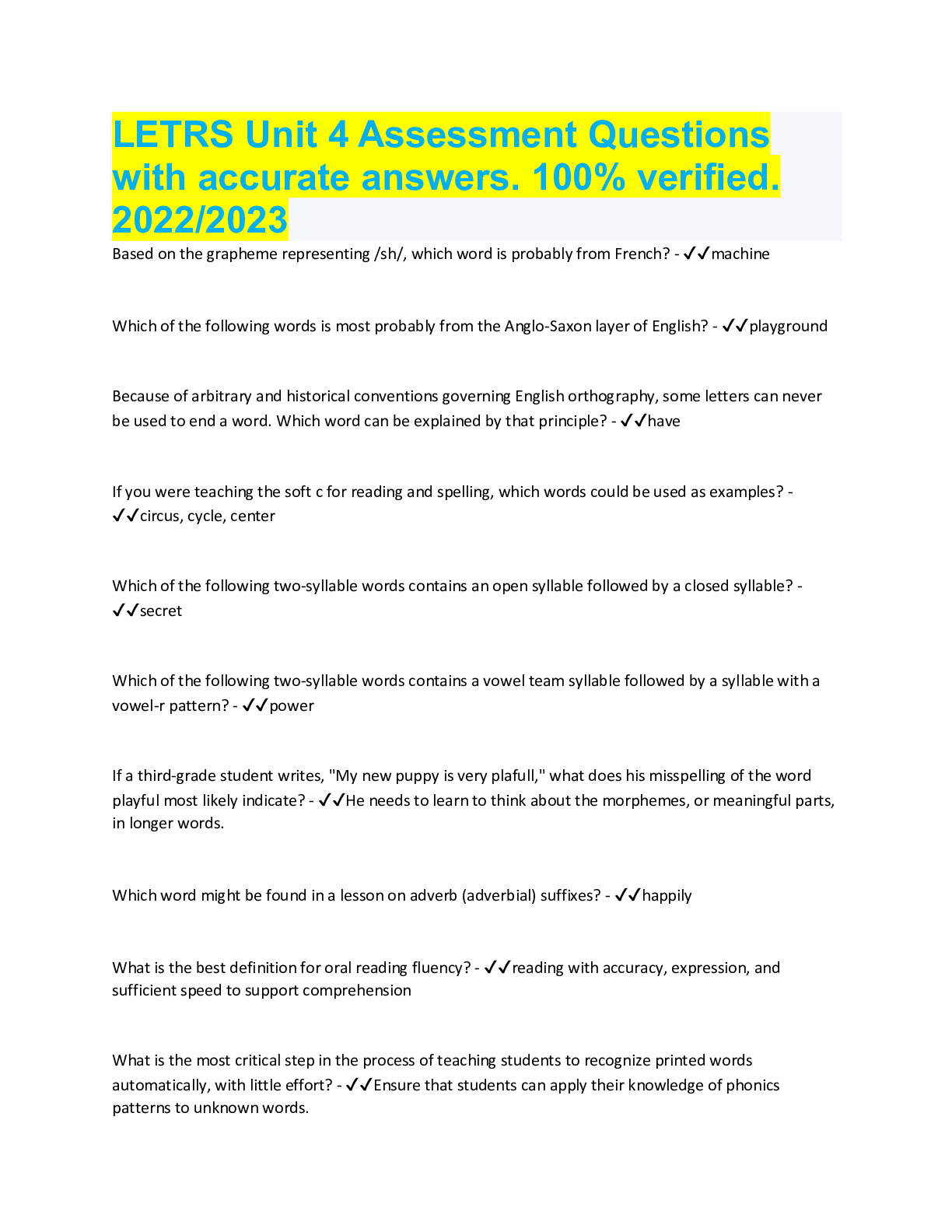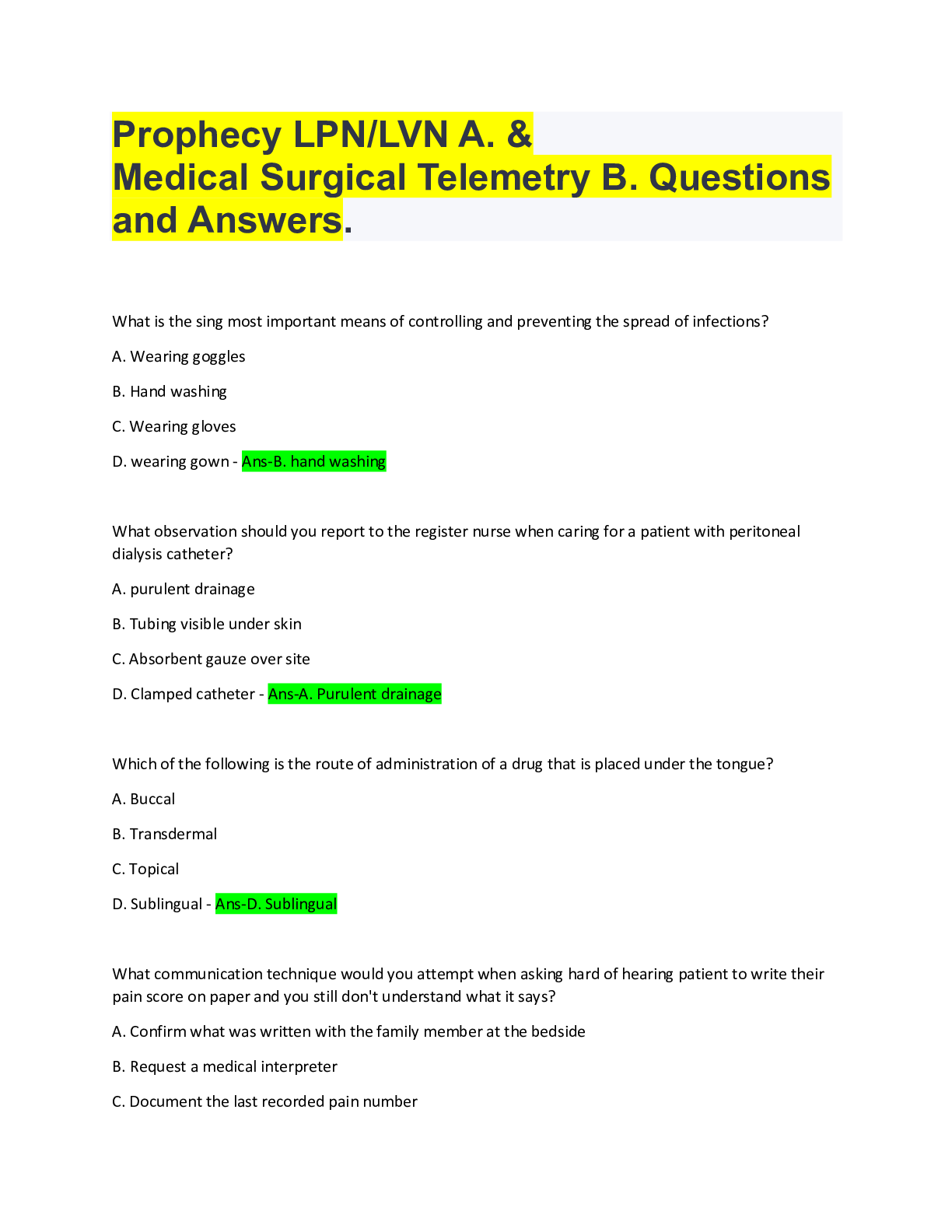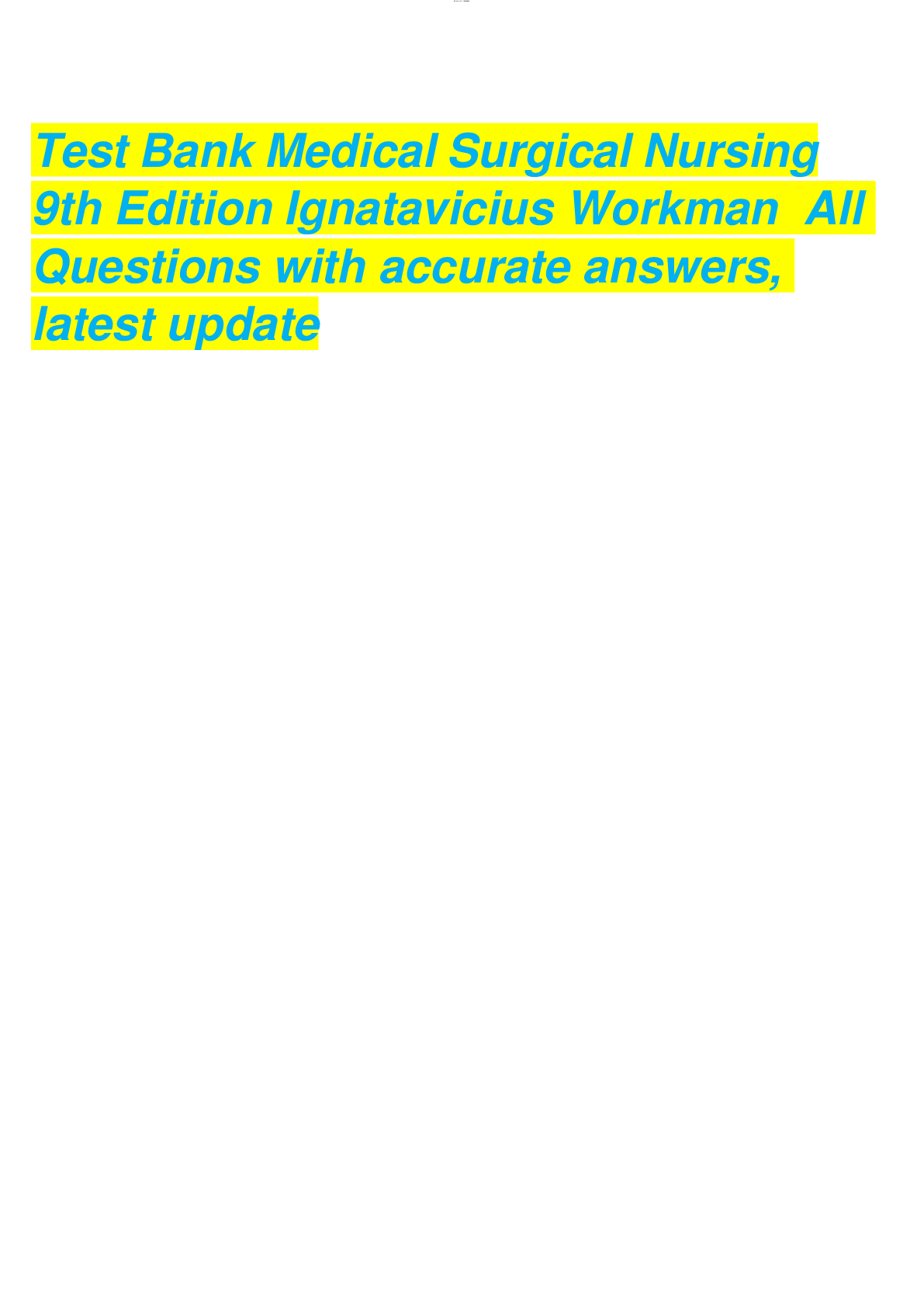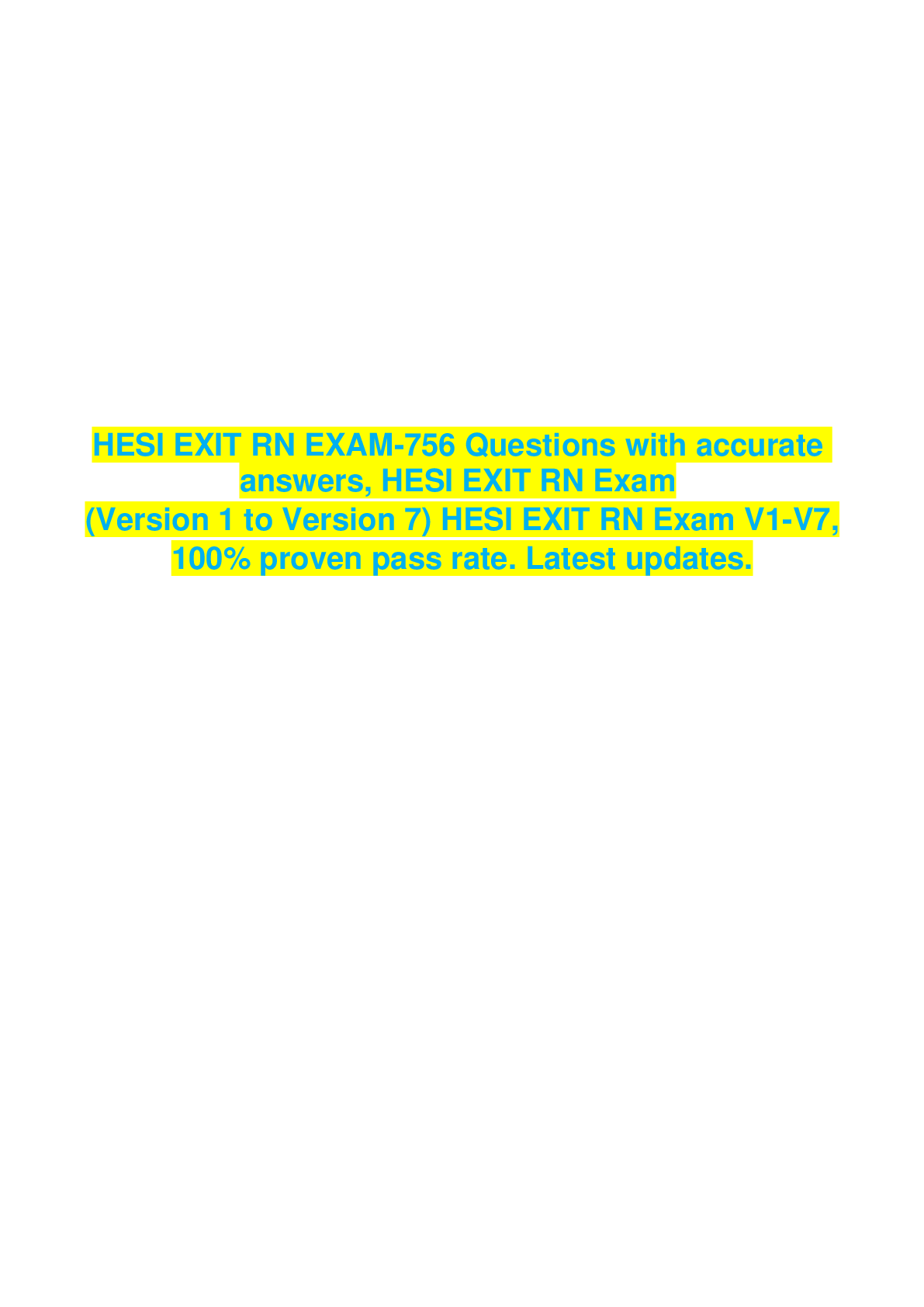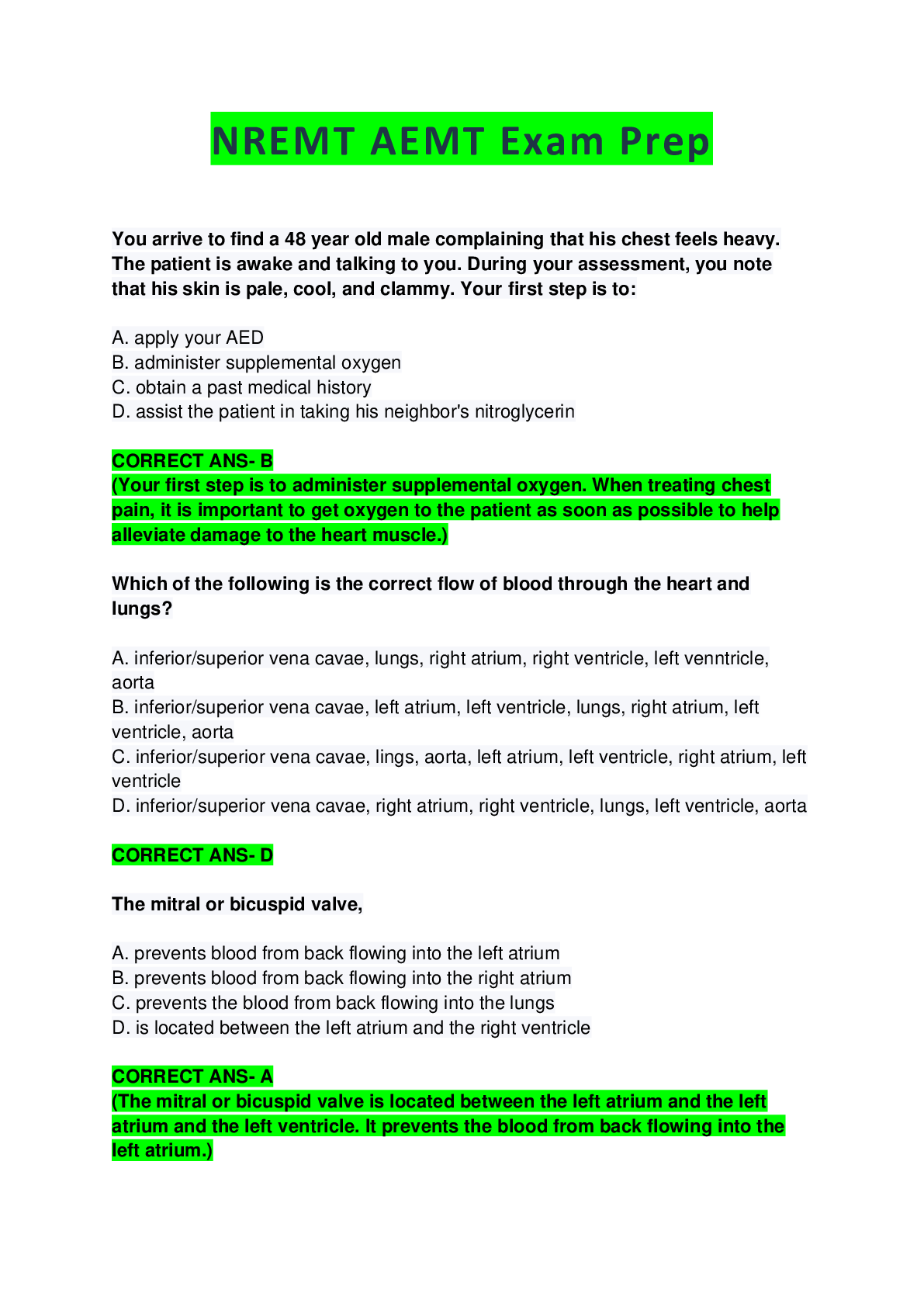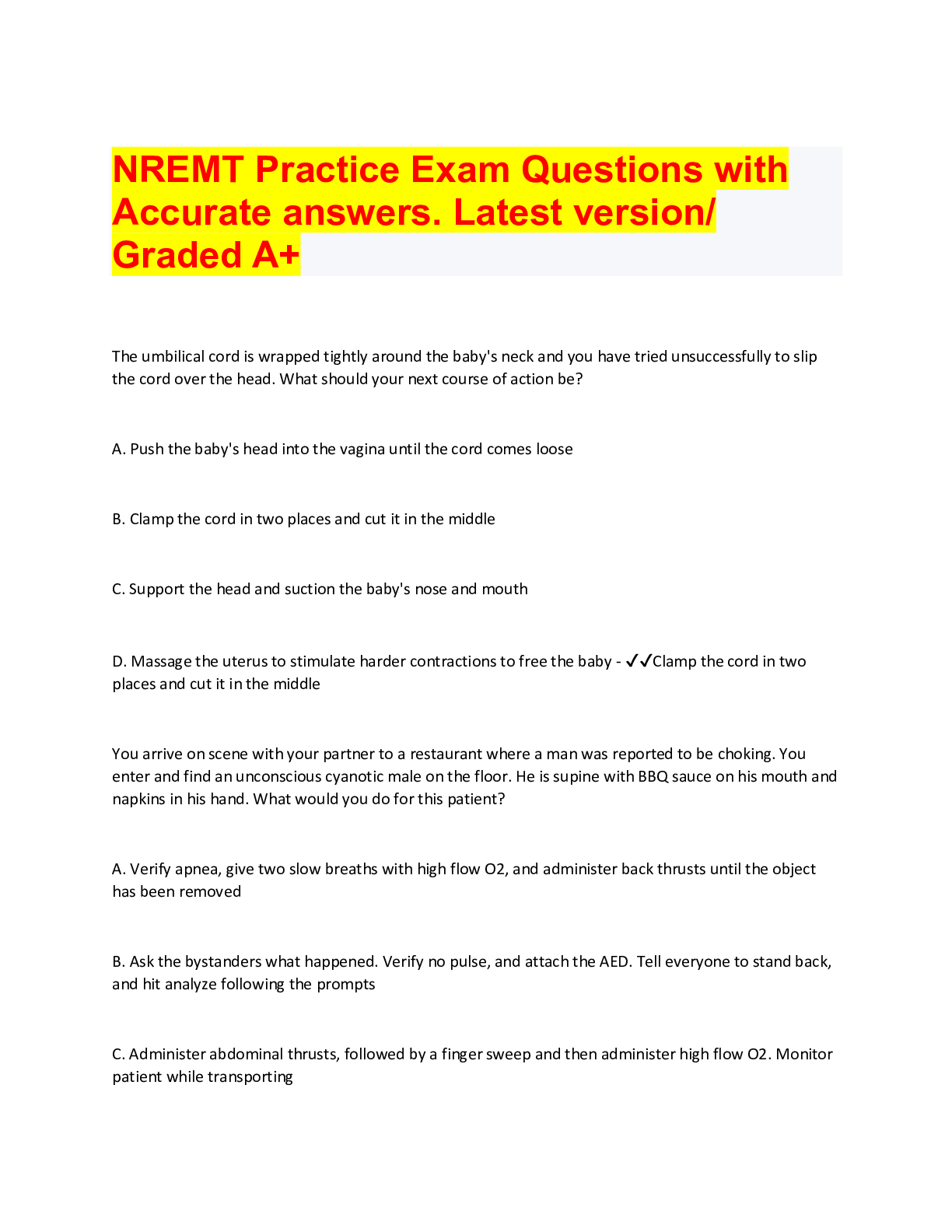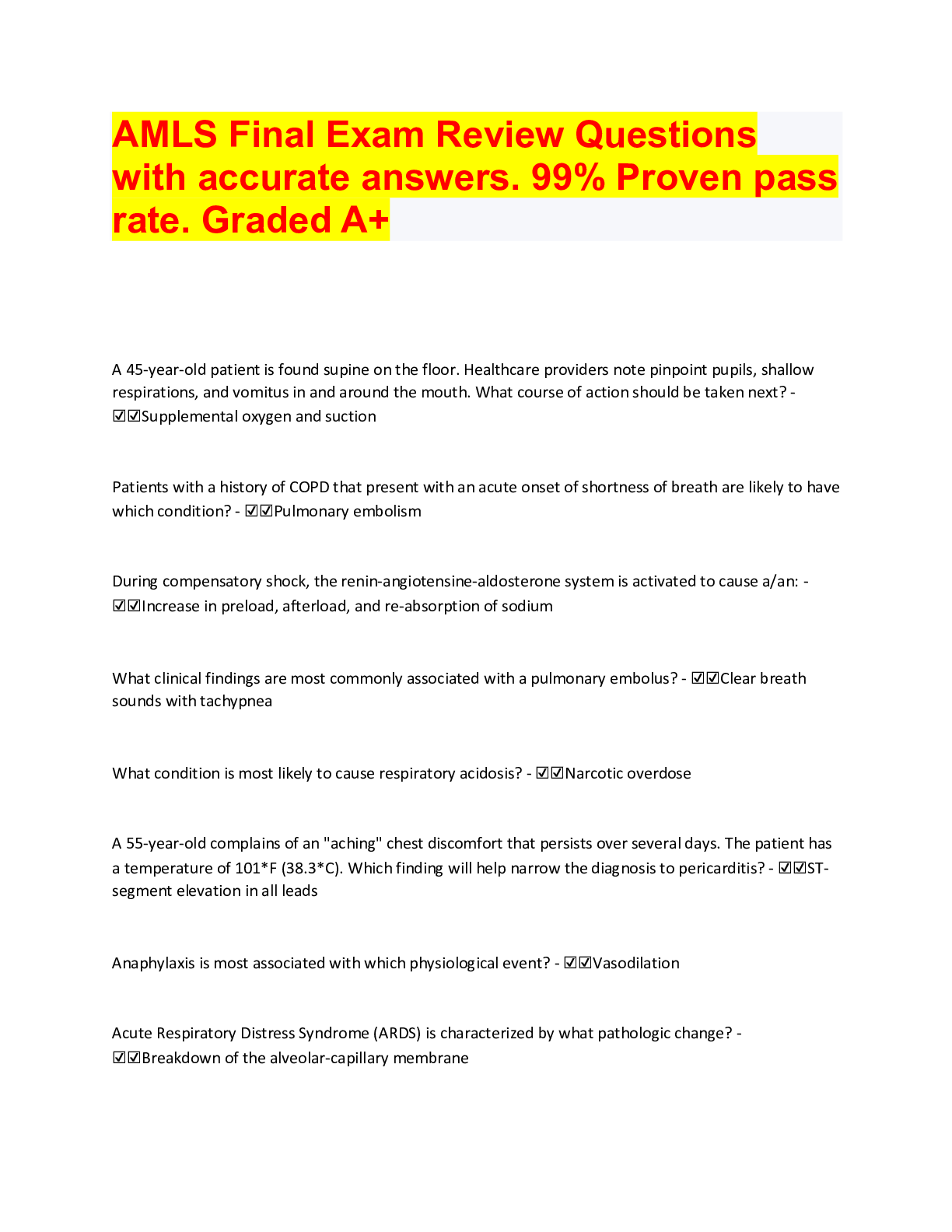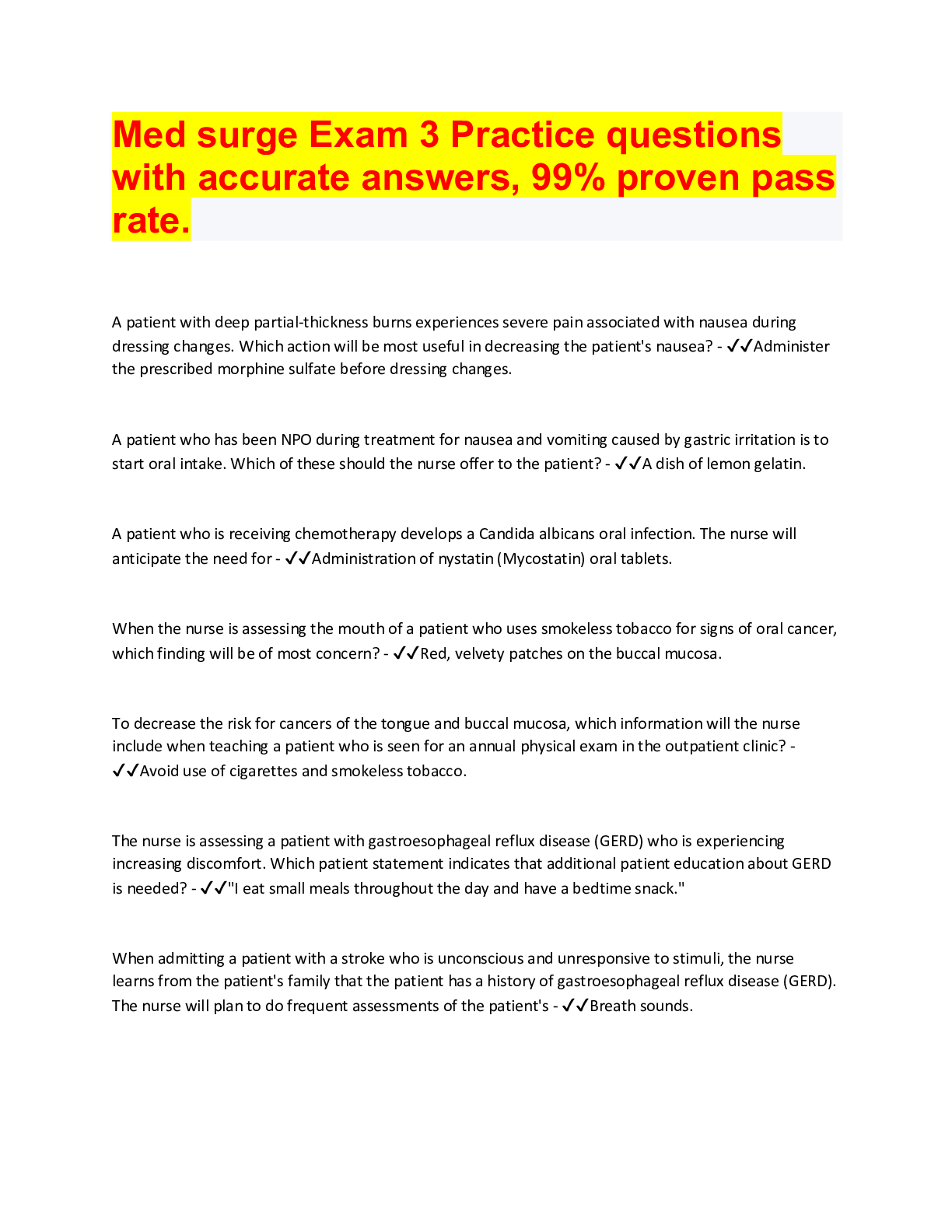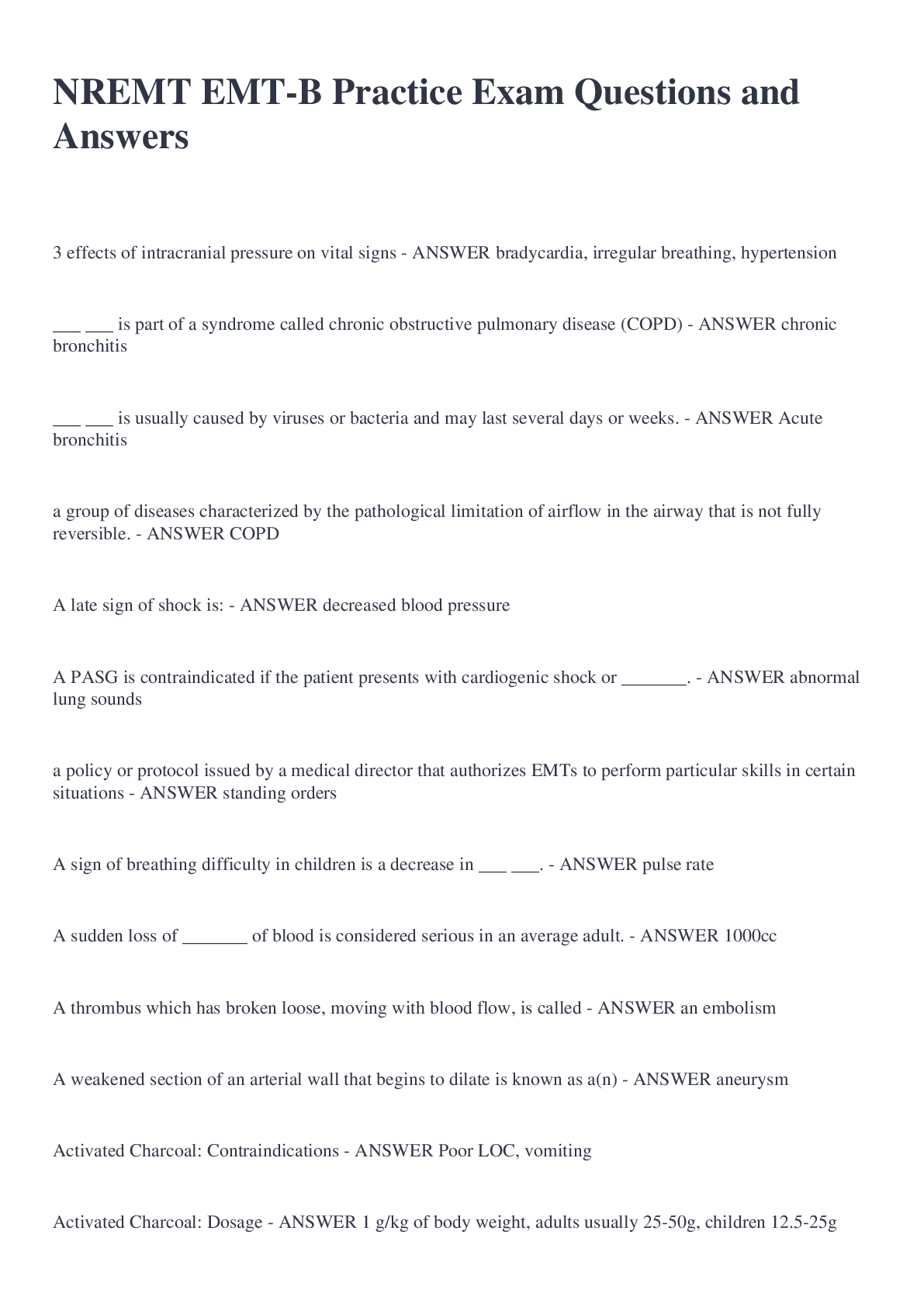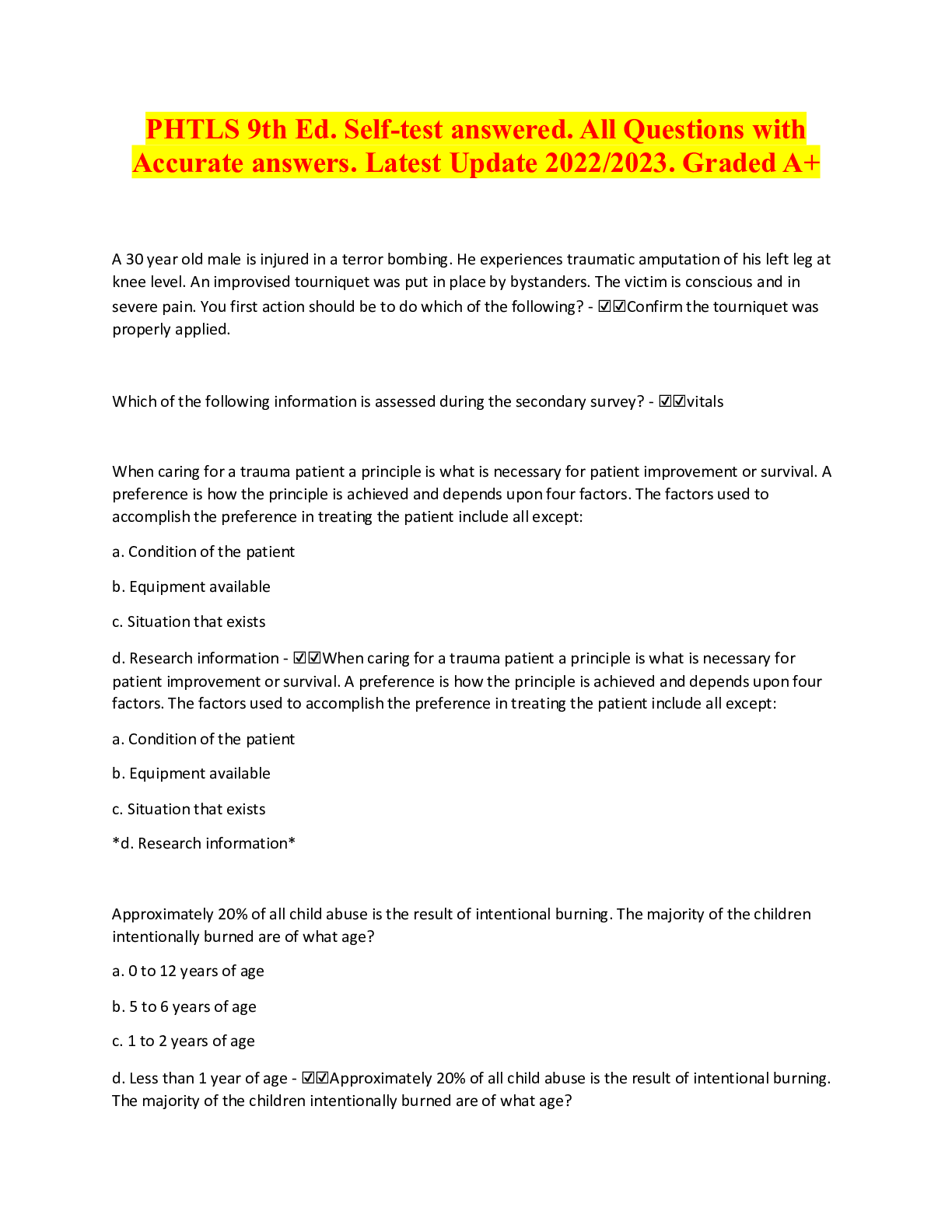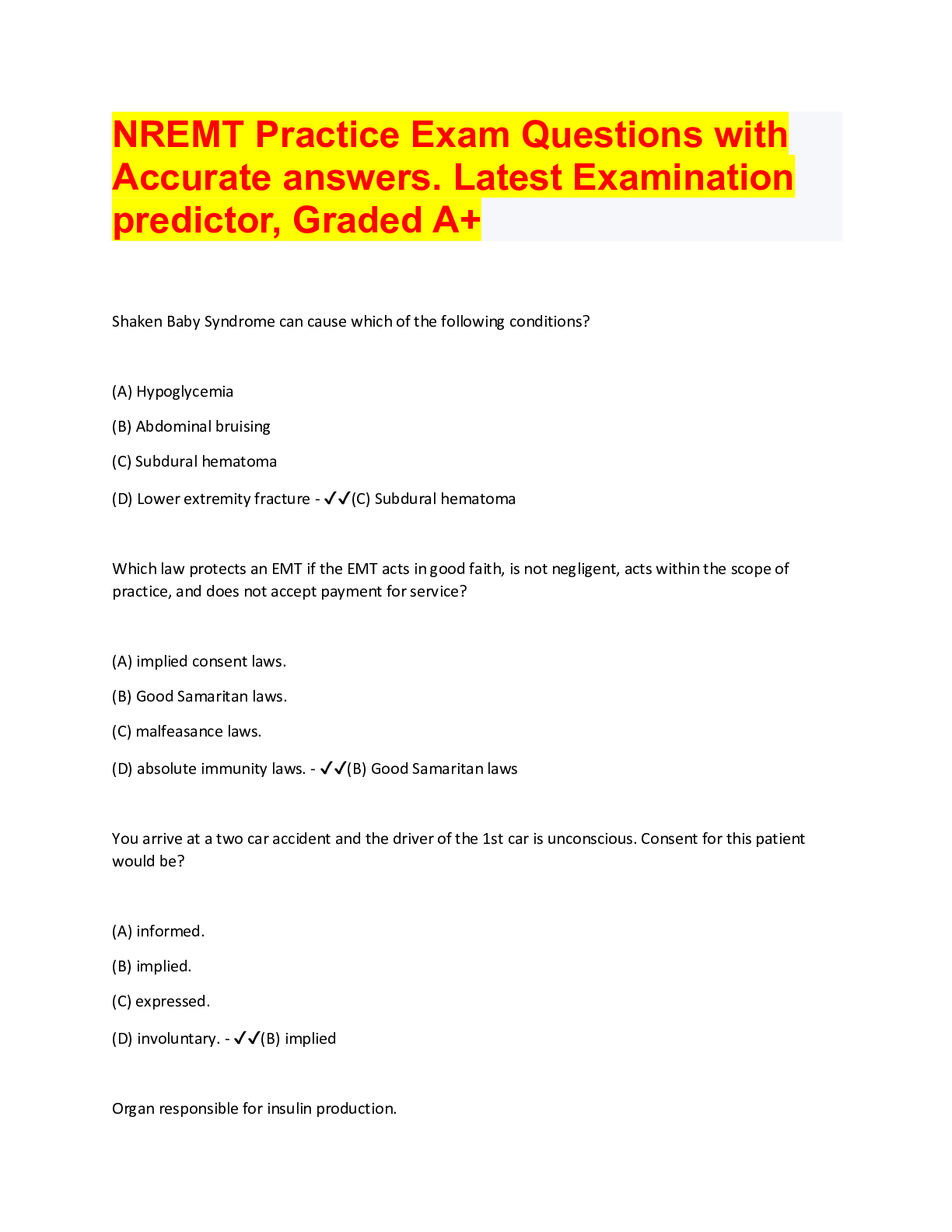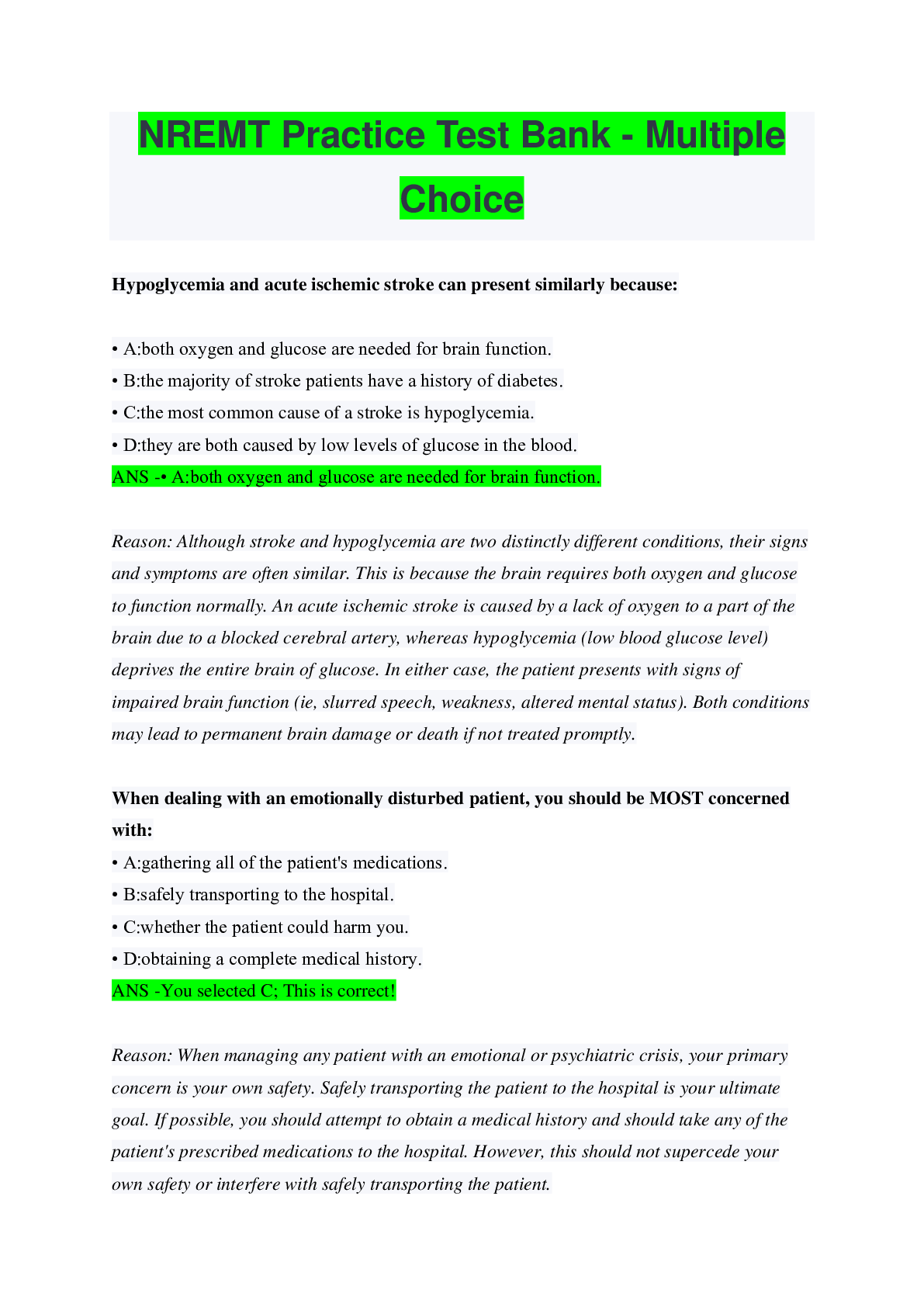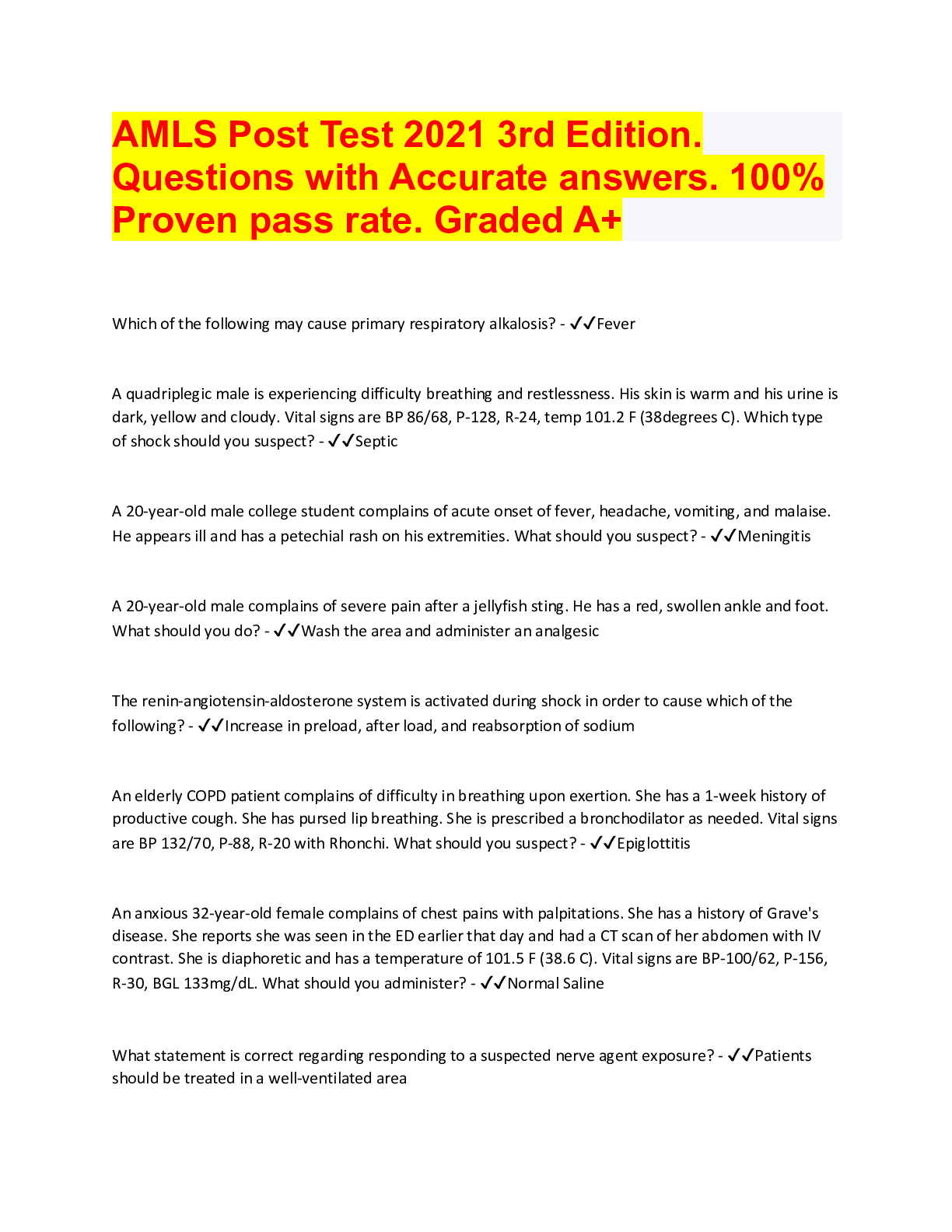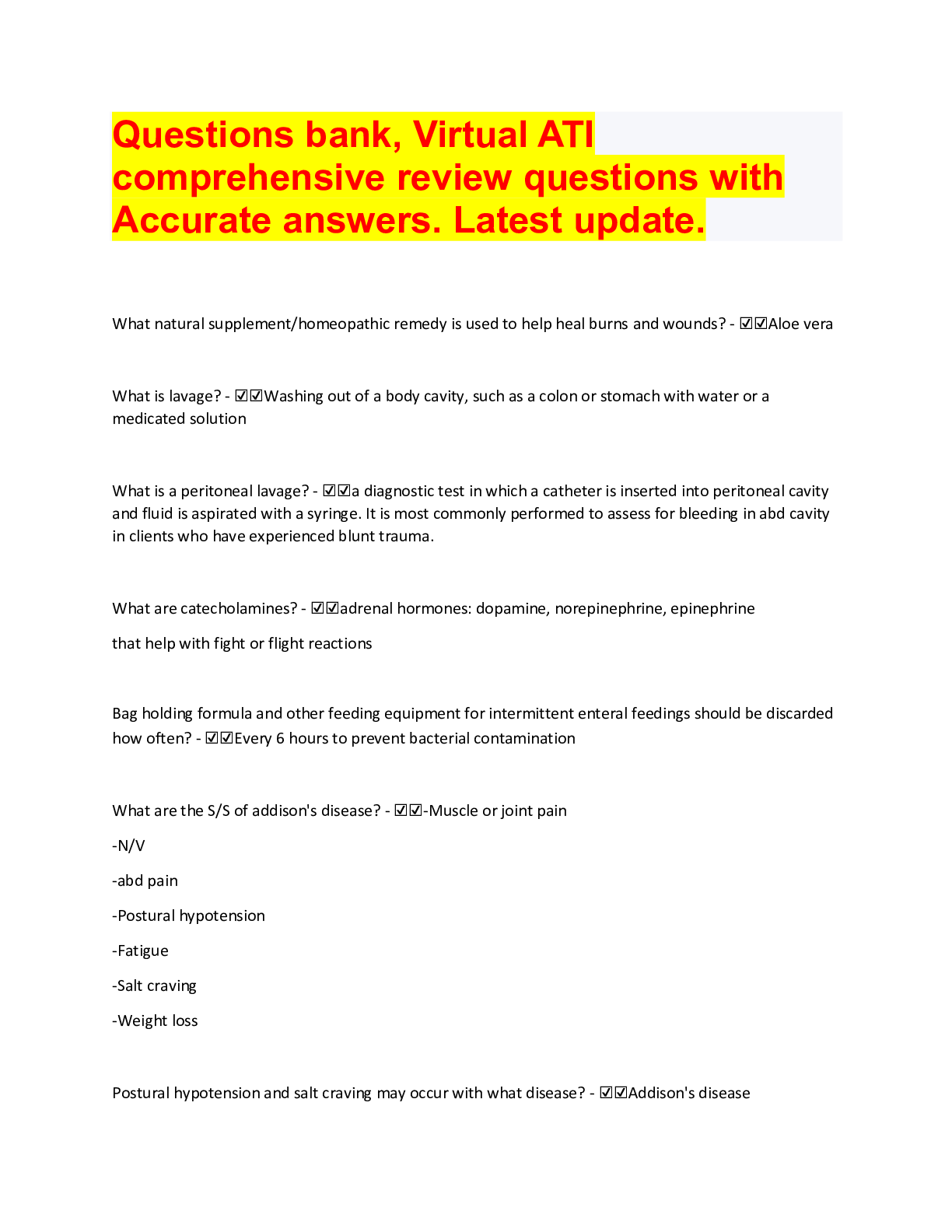*NURSING > QUESTIONS & ANSWERS > WALDEN UNIVERSITY, Completed Week 9 quiz, NURS 6521N, QUESTIONS WITH ACCURATE FEEDBACK. RATED A+ (All)
WALDEN UNIVERSITY, Completed Week 9 quiz, NURS 6521N, QUESTIONS WITH ACCURATE FEEDBACK. RATED A+
Document Content and Description Below
Question 1 1 out of 1 points A middle-aged patient has received a diagnosis of GI stromal tumor following an extensive diagnostic workup. Imatinib has been recommended as a component of the patien... t's drug regimen. What patient education should the nurse provide to this patient? Response Feedback: Patients must understand the importance of reporting edema of weight gain while taking imatinib. The patient will not likely have a PICC line. Nausea and dry mouth are not common adverse effects and the patient should not unilaterally stop taking the drug. Question 2 1 out of 1 points A nurse is assessing a patient who has chronic lymphoblastic myelogenous leukemia. The treatment plan includes hydroxyurea (Hydrea). The nurse will assess the patient for which of the following? Response Feedback: Hydroxyurea may be contraindicated in patients with low WBCs. The drug is not contraindicated with diabetes mellitus, hypertension, or hypoglycemia. Question 3 1 out of 1 points A nurse has been assigned to a 55-year-old woman who has a malignant brain tumor. The patient is receiving her first dose of carmustine. It will be critical for the nurse to observe for which of the following? Response Feedback: Respiratory difficulty can indicate a hypersensitivity reaction or anaphylaxis. The nurse would report any breathing difficulties immediately to the physician. If the patient does not eat or drink for more than 24 hours, the physician should be notified. Nausea and vomiting are adverse effects of the drug therapy, and an antiemetic regimen would be appropriate. Reddish urine is an adverse effect of doxorubicin, not carmustine. Question 4 1 out of 1 points An oncology nurse is reviewing the pathophysiology of cancer and is discussing with a colleague the factors that contribute to the success or failure of a patient's chemotherapy. Which of the following cancerous cells is most susceptible to the effects of chemotherapeutic drugs? Response Feedback: Cells that have a short generation time or rapid mitotic rate are most sensitive to antineoplastic agents. All cells (both cancerous and noncancerous) have a blood supply. A lack of contact inhibition is characteristic of cancer, but this is not associated with susceptibility to chemotherapeutic drugs. Question 5 1 out of 1 points Which of the following patients will be at the greatest risk for anemia and would be the most likely candidate for epoetin alfa therapy? Response Feedback: Older adults who have cancer and are receiving chemotherapy are especially vulnerable to the adverse effects of anemia as a result of chemotherapy and would therefore be the most likely candidates for epoetin alfa therapy. Young adults over age 18, pregnant women, and patients with a high white blood cell count are not as vulnerable to anemia and would not require epoetin alfa therapy. Question 6 1 out of 1 points A 67-year-old man who is being treated for prostate cancer is taking epoetin alfa. The nurse will instruct the patient to Response Feedback: After each dose adjustment, the nurse should ensure that the patient makes an appointment to have the hemoglobin measured twice a week for at least 2 to 6 weeks to verify that it is in the normal range. A high WBC count and hypertension have not been identified as adverse effects of epoetin alfa. Question 7 1 out of 1 points A 60-year-old patient experienced a sudden onset of chest pain and shortness of breath and was subsequently diagnosed with a pulmonary embolism in the emergency department. The patient has been started on an intravenous heparin infusion. How does this drug achieve therapeutic effect? Response Feedback: Heparin, along with antithrombin, rapidly promotes the inactivation of factor X, which, in turn, prevents the conversion of prothrombin to thrombin. Heparin does not achieve its therapeutic effect through the excretion or inhibition of vitamin K or by inhibiting platelet aggregation. Question 8 1 out of 1 points A nurse is caring for a patient with cancer who has been prescribed dronabinol (Marinol) to help reduce nausea and vomiting from chemotherapy. The nurse will inform the patient that he or she is taking an oral form of Response Feedback: The major ingredient of Marinol is 9-tetrahydrocannabinol (THC), the active ingredient in marijuana. Question 9 1 out of 1 points A male patient is receiving rituximab therapy for non-Hodgkin's lymphoma. Which of the following would be a priority nursing intervention to reduce the risk for cytotoxicity and tumor lysis syndrome? Response Feedback: Ensuring that the patient maintains a normal fluid and electrolyte balance is critical to maintaining a consistent drug dilution in the body and therefore limiting the risk of cytotoxicity and tumor lysis syndrome. Ensuring that the patient maintains a normal breathing pattern, is protected from exposure to infections, and does not develop renal impairment are also important nursing responsibilities; however, they do not help to significantly reduce the risk for cytotoxicity and tumor lysis syndrome. Question 10 1 out of 1 points A nurse is caring for a 64-year-old female patient who is receiving IV heparin and reports bleeding from her gums. The nurse checks the patient's laboratory test results and finds that she has a very high aPTT. The nurse anticipates that which of the following drugs may be ordered? Response Feedback: If a patient who receives IV heparin is found to be highly anticoagulated, protamine sulfate may be prescribed. Protamine sulfate, which is a strong base, reacts with heparin, which is a strong acid, to form a stable salt, thereby neutralizing the anticoagulant effects of heparin. Protamine sulfate does not produce the same effects for coumadin, alteplase, or ticlopidine. Question 11 1 out of 1 points A patient has completed 4 weeks of treatment with epoetin alfa. Which of the following assessment findings would most strongly indicate that treatment has been effective? Response Feedback: The most clinically significant indicator of the effectiveness of treatment with EPO is the patient's hemoglobin level. Respiratory status, peripheral circulation, and leukocyte levels are relevant to the patient's overall health status, but these do not directly suggest the success of failure of EPO treatment. Question 12 1 out of 1 points When planning care for a patient who is receiving filgrastim (Neupogen) for a nonmyeloid malignancy, the nurse should formulate which of the following patient outcomes? (Select all that apply.) Response Feedback: Desired outcomes for a patient receiving filgrastim include that febrile neutropenia will be avoided and infection and bone pain [Show More]
Last updated: 1 year ago
Preview 1 out of 10 pages
.png)
Reviews( 0 )
Document information
Connected school, study & course
About the document
Uploaded On
Mar 19, 2022
Number of pages
10
Written in
Additional information
This document has been written for:
Uploaded
Mar 19, 2022
Downloads
0
Views
60

.png)
